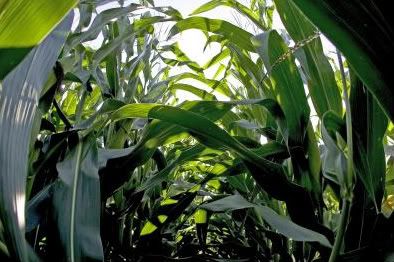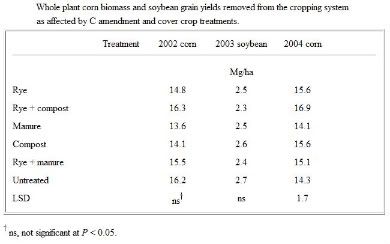Cover crops and composting can offset carbon loss from corn stover ethanol production

However, in the November-December 2008 issue of Agronomy Journal, scientists from Michigan State University show that with 'carbon augmentation' practises, even corn fields can become carbon sinks. They report on the effectiveness of the integration of cover crops, manure, and compost, to supplant carbon loss in corn stover removed by cropping systems. The results indicate that corn stover based bioenergy cropping systems can be managed to increase short-term carbon sequestration rates and reduce overall net global warming potential by using no-till planting methods and a manure-based nutrient management system [note: no mention of biochar yet - which may be a vastly superior carbon augmentation practise, because it doesn't merely sequester carbon temporarily, it does so quasi-permanently; in some types of soil, biochar also improves some of the most important soil functions, thus reducing fertilizer needs and lowering emissions of potent greenhouse gases like N2O and CH4].
The MSU research team measured soil carbon changes as well as nitrous oxide and methane gas emissions from corn stover-ethanol field plots managed under various carbon augmentation practices (table, click to enlarge). In addition to the gas emissions measured in the field, other carbon emissions assessed included estimates for the manufacturing carbon cost of crop inputs; methane emissions from the livestock manure source; methane and nitrous oxides generated during manure storage and application; and the fuel used in crop production and in gathering and land applying the manure.
“These results show that bioenergy cropping systems, particularly those integrating livestock manure into their management scheme, are a win-win option on both alternative energy and environmental fronts,” says Kurt Thelen, member of the research team.
Thelen says this research demonstrates that under proper management, livestock manure can supplant carbon lost from corn stover removal, and actually provide an environmental benefit, both in terms of greenhouse gas (GHG) mitigation, and from the established improved soil properties associated with increasing SOC levels such as increased water retention:
 energy :: sustainability :: biomass :: bioenergy :: biofuels :: ethanol :: corn :: cellulosic :: soil carbon :: no-till :: cover crops :: manure :: biochar ::
energy :: sustainability :: biomass :: bioenergy :: biofuels :: ethanol :: corn :: cellulosic :: soil carbon :: no-till :: cover crops :: manure :: biochar :: For every gallon of gasoline burned, the equivalent of 19 lbs of CO2 is released to the atmosphere which contributes to the environmental GHG problem, says Thelen. Conversely, this work shows that in the not too distant future, choosing a cellulosic ethanol alternative at the pump may actually result in a net removal of CO2 from the atmosphere.
Research is ongoing at Michigan State University to evaluate the environmental, agronomic, and economic sustainability of bioenergy cropping systems. Support for this work was provided by USDA-CSREES, the CASMGS program, and the Michigan Agricultural Experiment Station.
Picture: Harvesting corn leaves and stems for use in biofuel production reduces carbon in the soil, the researchers found. The more material harvested, the less carbon in the soil. Credit: Photo by Don Hamerman.
References:
Bradley E. Fronning, Kurt D. Thelen and Doo-Hong Min, "Use of Manure, Compost, and Cover Crops to Supplant Crop Residue Carbon in Corn Stover Removed Cropping Systems", Agronomy Journal, 100:1703-1710 (2008), DOI: 10.2134/agronj2008.0052
Biopact: Perennial biomass crops build soil carbon - December 04, 2008
 --------------
--------------
 Taiwan's Feng Chia University has succeeded in boosting the production of hydrogen from biomass to 15 liters per hour, one of the world's highest biohydrogen production rates, a researcher at the university said Friday. The research team managed to produce hydrogen and carbon dioxide (which can be captured and stored) from the fermentation of different strains of anaerobes in a sugar cane-based liquefied mixture. The highest yield was obtained by the Clostridium bacterium.
Taiwan's Feng Chia University has succeeded in boosting the production of hydrogen from biomass to 15 liters per hour, one of the world's highest biohydrogen production rates, a researcher at the university said Friday. The research team managed to produce hydrogen and carbon dioxide (which can be captured and stored) from the fermentation of different strains of anaerobes in a sugar cane-based liquefied mixture. The highest yield was obtained by the Clostridium bacterium.









0 Comments:
Post a Comment
Links to this post:
Create a Link
<< Home